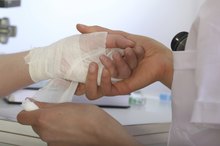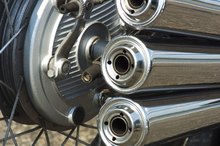How to Treat Steam Burns
Steam is about 212 F (100 C), so even brief exposure can burn your skin. Steam burns often occur in the kitchen, such as when you lift the lid off a pot of boiling liquid or open a dish you've just taken out of the microwave. Steam burns are often superficial and minor, primarily because reflexively pulling away from the heat source limits the time your skin is exposed to the high temperature. Small, superficial steam burns can often be treated at home. Large or more severe burns and those involving the face, feet or genitals require immediate medical evaluation and treatment 1.
Immediately cool the burned area with gently running tap water. Keep the burned area under the cool running water for 20 minutes. This will arrest the burning process, ease your pain and limit swelling. The water should be cool but not extremely cold. Alternatively, you can serially apply towels soaked in cool water for 20 minutes.
Do not apply ice or a frozen cold pack to the area as the extreme cold could further damage the burned skin.
How to Treat Burns Caused by Boiling Water
Learn More
After cooling the burned area, assess the size of the burn. If the burned area is larger than the palm of your hand, gently cover the area with a clean, dry cloth and seek urgent medical care. For smaller burns that do not involve the face, feet or genitals, home care is usually safe and effective. See warnings for other situations that require urgent medical care.
Gently dry the burned area. Minor, superficial steam burns usually do not need to be covered. However, you might want to bandage the area for comfort. Loosely apply a sterile gauze pad to avoid putting pressure on the burn. If the area is blistered, use a nonstick pad to prevent the bandage from sticking to the burn.
If the skin is intact, you might consider applying a lotion containing aloe to the burned area for additional pain relief. Do not apply butter or oil to the burn.
How to Treat a Burn on the Fingers
Learn More
If you are in pain, you might consider taking an over-the-counter pain reliever such as acetaminophen (Tylenol) or ibuprofen (Advil, Motrin). Check with your doctor if you are uncertain whether an over-the-counter pain reliever is safe for you.
Change the dressing daily until the area is no longer painful. Minor, superficial steam burns usually heal within 5 to 6 days.
Reviewed and revised by: Tina M. St. John, M.D.
Warnings
Watch for signs and symptoms of infection, including increasing pain, expanding redness, red streaks radiating from the burn site, or a fever. See your doctor right away if any of these signs or symptoms develop.
See urgent medical care if the burn involves your face, feet or genitals, or if you inhaled the steam.
See your health care provider for appropriate treatment of your burn if you have diabetes or a weakened immune system.
If your child sustains a steam burn, contact your doctor right away for care instructions.
Related Articles
References
- BMJ: First Aid and Treatment of Minor Burns
- American Burn Association: Initial First Aid Treatment for Minor Burns
- Advanced Assessment and Treatment of Trauma; Michael D. Panté
- American Burn Association. Scald statistics and data resources. Updated August 13, 2018.
- Al Himdani S, Javed MU, Hughes J, et al. Home remedy or hazard?: management and costs of paediatric steam inhalation therapy burn injuries. Br J Gen Pract. 2016;66(644):e193-9. doi:10.3399/bjgp16X684289
- Singh M, Singh M, Jaiswal N, Chauhan A. Heated, humidified air for the common cold. Cochrane Database Syst Rev. 2017;8:CD001728. doi:10.1002/14651858.CD001728.pub6
- Kudchadkar SR, Hamrick JT, Mai CL, Berkowitz I, Tunkel D. The heat is on...thermal epiglottitis as a late presentation of airway steam injury. J Emerg Med. 46(2):e43-6. doi:10.1016/j.jemermed.2013.08.033
- Bagirathan S, Rao K, Al-Benna S, O'Boyle CP. Facial burns from exploding microwaved foods: Case series and review. Burns. 2016;42(2):e9-e12. doi:10.1016/j.burns.2015.02.014
- U.S. National Library of Medicine, MedlinePlus. Burns. Reviewed May 24, 2018.
- Burn Institute. Scald burns: safety tips and info. (no date).
- Centers for Disease Control and Prevention. Burn prevention. Updated February 6, 2019.
- Ansari Z, Brown K, Carson N. Association of epilepsy and burns - a case control study. Aust Fam Physician. 2008;37(7):584-589.
- Koljonen V. Hot air sauna burns--review of their etiology and treatment. J Burn Care Res. 2009;30(4):705-710. doi:10.1097/BCR.0b013e3181abfa9f
Writer Bio
Janelle Vaesa received her Master of Public Health degree in 2008 and Bachelor of Science in health and human performance in 2006, both from the University of Louisville. Vaesa has worked in a variety of settings, focusing on improving the health of clients. Vaesa began running in 2000 and in 2005 began racing in triathlons.







